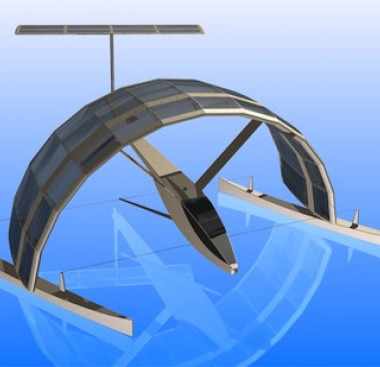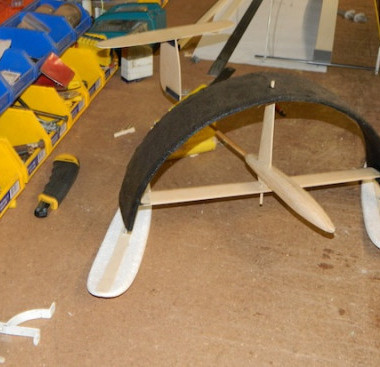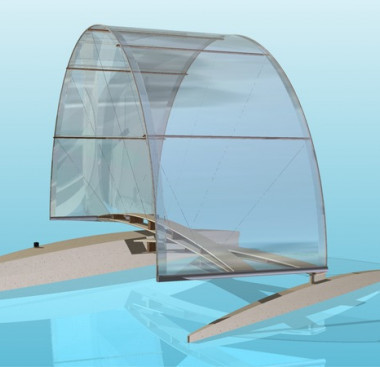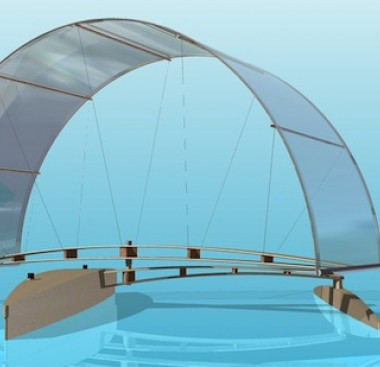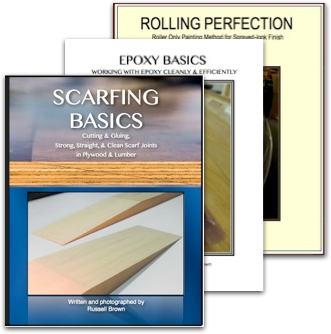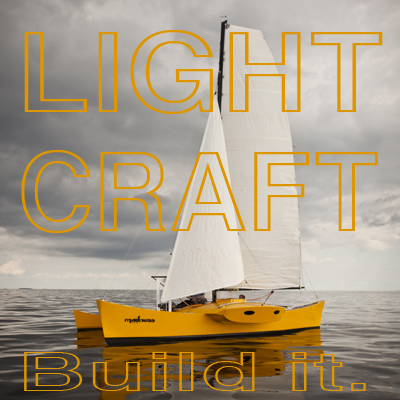The ArcSail Proa
Malcolm Smith always has something really tasty cooking in his workshop. His latest project is a force-balanced design utilizing a ‘ring wing’ that he calls the ArcSail. The concept has huge potential for boats both large and small, and I’m very pleased that Malcolm has opted to share it with us at Proa File -Editor
I have a long time fascination with sailing boat configurations that minimize heeling moment, due to their potential for higher speeds. Over the last 30 years or so, apart from producing hundreds of sketches and drawings, I have built quite a few sailing models with canted rigs and foils and/or stabilizing wings. What I have learned is that while the potential is there, the realization of that potential is plagued by the constraints of reality.
In order to minimize the heeling moment of a sailing yacht, you simply align the thrust vector of the sail with the reaction vector of the hull and foils. The downside is that (1) you need significant horizontal separation between the sail and the foil and (2) both the sail and the foil need to be canted over at an angle. These two constraints add weight to the structure and reduce the efficiency of the sail and foils. Hence low heeling moment configurations will be less efficient than traditional ballasted configurations at least up until the point where the ballasted system runs out of righting moment. (Editor’s note: “ballasted” includes any yacht that relies upon weight, or “ballast” to windward of the center of buoyancy in order to carry sail. This includes ballasted monohulls as well as normal multihulls, and proas.)
Given the level of development of ballasted systems (look at Banque Populaire, which has just circled the globe in less than 46 days), designing a workable low heeling moment boat which can match traditional boats in light conditions is a difficult task. I have been taught this lesson many times, but I still can’t let it go. So ArcSail is my latest attempt at a workable solution.
Many of my previous designs and sketches featured a canted biplane sail arrangement, a bit like the Hobie Trifoiler arrangement but with more extreme cant angles. The ArcSail configuration came from attempting to blend the two canted sails together at the head to form a single airfoil. Once I had drawn it, I realized that it shared similar characteristics with the ‘ring wing’ concept that has been proposed for aircraft, in terms of gains in aerodynamic efficiency. According to theory, blending two separate foils together at the tip reduces induced drag by a significant amount. The width of a low heeling moment rig means that choice a suitable platform is usually limited to a multihull. I often choose a proa configuration for it’s low hull drag characteristics. Another suitable configuration is the slewing catamaran configuration. I have adapted the ArcSail concept to both of these configurations. Hence we have the ArcSail Proa and the ArcSail Slewing Catamaran.
The ArcSail Slewing Catamaran features a tail which provides both horizontal stability and keeps the sail correctly aligned with the apparent wind. It should be inherently self steering and dynamically stable. The way it is configured it can’t sail very far off the apparent wind, a beam reach is about all it can manage (unless you sail it backwards, which is an option). Sailing it downwind requires that it sail very fast in order to generate large apparent wind angles. This is feasible as long as it can be built very lightly. It is not a boat that can carry a large payload, so it’s not particularly useful unless you simply want to go very fast.
The ArcSail Proa is a much more practical boat. A proa hull is easily driven and doesn’t need a huge sail plan to get up a reasonable turn of speed. The proa version is not designed as a high speed craft, more as an interesting and easy to sail cruising vessel. Because there is no heeling moment, the proa can be sailed equally well on either tack and it can also sail in either direction by shunting. It’s a boat that is inherently safe and maneuverable.
The most difficult part of designing the ArcSail itself is to design a lightweight structure. The slewing catamaran version features a solid thick aerofoil which would be expensive to build lightly.
The proa version of the ArcSail is, I think, much more interesting. It features a simple flat double edged aerofoil. It’s not an efficient section but one of the advantages of a ring wing is that it is very resistant to stall, so even a flat aerofoil should be capable of generating a reasonable amount of lift if a large angle of attack can be achieved. The flat aerofoil can be constructed by stretching a fabric sail between flexible glass fibre or carbon fibre tubes or rods on the leading and trailing edges. The flexible rods are held in the circular arc shape by using wire stays in the same manner as spokes on a bicycle wheel. Hence the fabric version of the sail will be lightweight and can be erected and stowed similarly to a flexible rod tent. The sail is mounted on a low windage cross beam that rotates on a short vertical shaft.
So much for the theory. I am currently constructing a 900mm test model of the Arcsail Proa to see if it will work in practice.”
Further Reading
Wikipedia: Closed Wing
Nonplanar Wing Concepts for Increased Aircraft Efficiency
Annular Wings vs. Straight Wings

